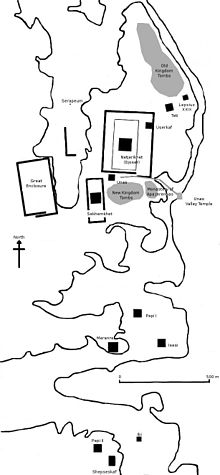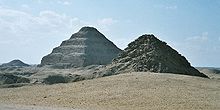Saqqara: Difference between revisions
m robot Adding: uk:Саккара |
|||
| Line 8: | Line 8: | ||
The name Saqqara is possibly derived from [[Seker|Sokar]], an ancient Egyptian funerary god. |
The name Saqqara is possibly derived from [[Seker|Sokar]], an ancient Egyptian funerary god. |
||
==History== |
==History==:) |
||
===Early Dynastic=== |
===Early Dynastic=== |
||
[[Image:Saqqara map.jpg|thumb]] |
[[Image:Saqqara map.jpg|thumb]] |
||
Revision as of 20:27, 7 December 2009
Saqqara (or Sakkara, Saqqarah; Arabic: سقارة) is a vast, ancient burial ground in Egypt, serving as the necropolis for the Ancient Egyptian capital, Memphis. Saqqara features numerous pyramids, including the world famous Step Pyramid, as well as a number of mastabas. Located some 30 km south of modern-day Cairo, Saqqara covers an area of around 7 km by 1.5 km.
At Saqqara, the oldest complete hewn-stone building complex known in history was built: Djoser's step pyramid, built during the third dynasty. 16 other Egyptian kings have built pyramids at Saqqara, which are now in various states of preservation or dilapidation. High officials have added private funeral monuments to this necropolis during the entire pharaonic period. It remained an important complex for non-royal burials and cult ceremonies for more than 3,000 years, well into Ptolemaic and Roman times.
North of the area known as Saqqara lies Abusir; south lies Dahshur. The area running from Giza to Dahshur has been used as necropolis by the inhabitants of Memphis at different times, and it has been designated as a World Heritage Site by UNESCO in 1979.[1]
The name Saqqara is possibly derived from Sokar, an ancient Egyptian funerary god.
==History==:)
Early Dynastic


The earliest burials of nobles can be traced back to the First Dynasty, at the north side of the Saqqara plateau. During this time, the royal burial ground was at Abydos. The first royal burials at Saqqara, comprising underground galleries, date to the Second Dynasty. The last Second Dynasty king Khasekhemwy was buried in his tomb at Abydos, but also built a funerary monument at Saqqara consisting of a large rectangular enclosure, known as Gisr el-Mudir. It probably inspired the monumental enclosure wall around the Step Pyramid complex. Djoser's funerary complex, built by the royal architect Imhotep, further comprises a large number of dummy buildings and a secondary mastaba (the so-called 'Southern Tomb'). French architect and Egyptologist Jean-Philippe Lauer spent the greater part of his life excavating and restoring Djoser's funerary complex.
Early Dynastic monuments
- tomb of king Hotepsekhemwy
- tomb of king Nynetjer
- Buried Pyramid, funerary complex of king Sekhemkhet
- Gisr el-Mudir, funerary complex of king Khasekhemwy
- Step Pyramid, funerary complex of king Djoser

Old Kingdom
Nearly all Fourth Dynasty kings chose a different location for their pyramids. During the second half of the Old Kingdom, under the Fifth and Sixth Dynasties, Saqqara was again the royal burial ground. The Fifth and Sixth Dynasty pyramids are not built of massive stone, but with a core consisting of rubble. They are consequently less well preserved than the world famous pyramids built by the Fourth Dynasty kings at Giza. Unas, the last ruler of the Fifth Dynasty, was the first king to adorn the chambers in his pyramid with Pyramid Texts. It was custom for courtiers during the Old Kingdom to be buried in mastaba tombs close to the pyramid of their king. Clusters of private tombs were thus formed in Saqqara around the pyramid complexes of Unas and Teti.
Old Kingdom monuments
- Mastabet el-Fara'un, tomb of king Shepseskaf (Dynasty 4)
- pyramid complex of king Userkaf (Dynasty 5)
- Haram el-Shawaf, pyramid complex of king Djedkare
- pyramid of king Menkauhor
- mastaba of Ti
- mastaba of the Two Brothers (Khnumhotep and Niankhkhnum|Niankhkhnum and Khnumhotep)
- pyramid complex of king Unas
- mastaba of Ptahhotep
- pyramid complex of king Teti (Dynasty 6)
- mastaba of Mereruka
- mastaba of Kagemni
- pyramid complex of king Pepi I
- pyramid complex of king Merenre
- piramid complex of king Pepi II
First Intermediate Period monuments
- pyramid of king Ibi (Dynasty 8)
Middle Kingdom
From the Middle Kingdom onwards, Memphis was no longer the capital of the country, and kings built their funerary complexes elsewhere. Few private monuments from this period have been found at Saqqara.
Second Intermediate Period monuments
New Kingdom
During the New Kingdom Memphis was an important administrative and military centre, second only to the capital. From the Eighteenth Dynasty onwards many high officials built tombs at Saqqara. When still a general, Horemheb built a large tomb here, though he was later buried as Pharaoh in the Valley of the Kings at Thebes.
Many monuments from earlier periods were still standing, but dilapidated by this period. Prince Khaemweset, son of Pharaoh Ramesses II, made repairs to buildings at Saqqara. Among other things, he restored the Pyramid of Unas and added an inscription to its south face to commemorate the restoration. He enlarged the Serapeum, the burial site of the mummified Apis bulls, and was later buried in the catacombs. The Serapeum, containing one undisturbed interment of an Apis bull and the tomb of Khaemweset, were rediscovered by the French Egyptologist Auguste Mariette.
New Kingdom monuments
- Several clusters of tombs of high officials, among which the tombs of Horemheb and of Maya and Merit. Reliefs and statues from these two tombs are on display in the National Museum of Antiquities at Leiden, the Netherlands, and in the British Museum, London.
After the New Kingdom
In the periods after the New Kingdsom, when several cities in the Delta served as capital of Egypt, Saqqara remained in use as a burial ground for nobles. Moreover the area became an important destination for pilgrims to a number of cult centres. Acitivities sprang up around the Serapeum, and extensive underground galleries were cut into the rock as burial sites for large amounts of mummified ibises, baboons, cats, dogs, and falcons.
Monuments of the Late Period, the Ptolemaeic Period and the Roman Period
- several shaft tombs of officials of the Late Period
- Serapeum (the larger part dating to the Ptolemaeic Period)
- the so-called 'Philosophers circle', a monument to important Greek thinkers and poets, consisting of statues of Hesiod, Homer, Pindar, Plato, and others (Ptolemaeic)
- several Coptic monasteries, among which the Monastery of Apa Jeremias (Byzantine and Early Islamic Periods)
See also
References
- ^ "Memphis and its Necropolis – the Pyramid Fields from Giza to Dahshur — UNESCO World Heritage Centre". Whc.unesco.org. Retrieved 2009-10-18.


